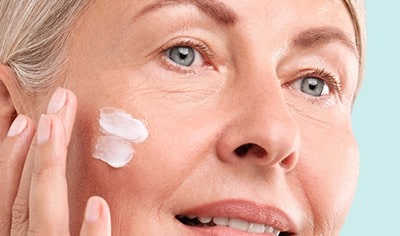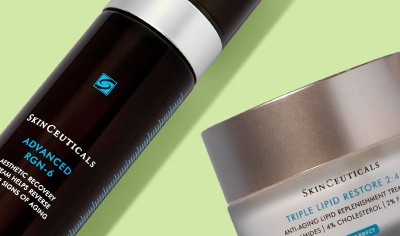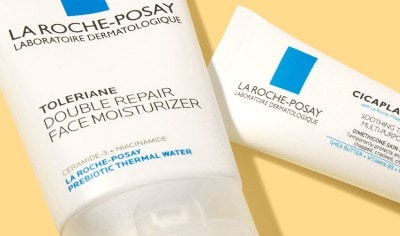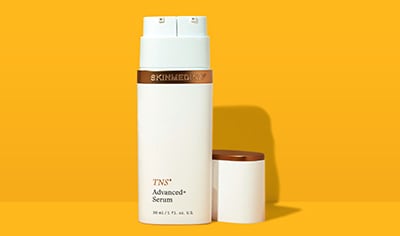
Navigating and understanding the ever-changing world of skin care can be overwhelming. While expert advice from a board-certified dermatologist is always the best choice, a quick, at-home guide to skin care definitions can help you between appointments. So, we’ve done just that! Our team of experts have pulled together a list of commonly used skin care terms and their meanings to create a comprehensive skin care dictionary of the most popular skin care ingredients, skin conditions, tools and even a few professional treatments to help guide you in your journey to beautiful, healthy skin.
A
afaLUXE™ - Featured in many LovelySkin LUXE products, afaLUXE™ is a dermatologist-developed molecule that encourages effective exfoliation with a non-irritating, yet low pH. This unique ingredient also works to improve skin’s moisture barrier.
Acne – Also known as pimples, blemishes or breakouts, acne can occur when pores become clogged with dirt, oil, makeup or debris. Certain acne will respond to over-the-counter treatments, while others may require a prescription regimen from a board-certified dermatologist.
Active ingredient – An active ingredient in skin care is the primary ingredient used to treat a skin condition like acne, wrinkles or discoloration. Active ingredients must be approved by the FDA to be designated as “active.”
Allantoin – A byproduct of uric acid that helps reduce skin irritation and other signs of inflammation. You’ll find allantoin in skin care products that support healing, such as scar creams, repair masks and post-procedure recovery treatments.
Alcohol – Solvent or astringent alcohols labeled as SD alcohol, denatured alcohol, isopropyl alcohol, methanol or ethanols can have a dehydrating effect on skin. Often found in products for oily skin, solvent alcohols can help other ingredients penetrate skin more effectively. However, fatty alcohols, often in the form of esters, can work as emollients to help nourish the skin.
Aloe vera (Aloe barbadensis leaf extract) – Aloe vera is a cactus plant-based extract that acts as a protective layer for the skin and replenishes lost moisture. It’s also effective for soothing sensitive skin or sunburn.
Alpha hydroxy acids (AHAs) – AHAs are a group of natural acids found in foods like fruit or sugar cane. They are used in skin care products to help exfoliate skin by dissolving the top layer of dead cells, revealing healthier skin beneath.
Amino acids – Categorized into essential and non-essential, amino acids are the building blocks of proteins and peptides that are essential for healthy skin.
Antioxidants – Antioxidants are naturally-occurring minerals and vitamins that protect skin against free radical damage. This damage, which can come from ozone pollution, smoke, infrared radiation and UVA/UVB rays, is also known to accelerate skin aging.
Arbutin – Arbutin is derived from the bearberry shrub, cranberries, blueberries, some mushrooms and pears. It offers melanin-inhibiting properties that help brighten skin discoloration.
Argan oil (Argania Spinosa Kernel Oil) – Produced from the shells of nuts that grow on argan trees in Morocco, argan oil helps soften skin and reduce the appearance of wrinkles. It is also used to help treat common skin issues, like psoriasis, acne, eczema and even split ends.
Ascorbic acid – Ascorbic acid is a stable form of vitamin C that acts as a powerful antioxidant. It helps reduce the appearance of fine lines and discoloration and stimulates collagen synthesis.
Avobenzone – Avobenzone is a synthetic active sunscreen ingredient that helps provide skin protection against the entire range of UVA rays.
Azelaic acid – Azelaic acid is an agent derived from wheat, barley or rye that helps lighten skin and reduce bacteria.
B
Bakuchiol – An anti-aging skin care ingredient that’s often hailed as a gentler alternative to retinol. Bakuchiol is derived from the seeds of Psoralea corylifolia, also known as the babchi plant. Skin benefits include targeting skin discoloration and diminishing fine lines and wrinkles.
Beeswax (Cera alba) – Derived from the walls of beehives, beeswax helps holds in moisture, prevent clogged pores and acts as a thickening agent when used in cosmetic formulas.
Bentonite – Bentonite is a type of clay formed from volcanic ash that helps absorb excess oil and treat acne breakouts. It is also said to have anti-inflammatory properties, which makes it a great ingredient for those with oily or acne-prone skin.
Benzoyl peroxide – Also known as BPO, benzoyl peroxide is a chemical compound that releases oxygen to kill acne-causing bacteria, remove excess oils and exfoliate dead skin cells that can clog pores.
Beta hydroxy acids (BHAs) – BHAs are organic compounds that penetrate the skin to clear and unclog pores, preventing breakouts. Salicylic acid is a BHA.
Bisabolol - Bisabolol is an oil derived from German chamomile that has anti-inflammatory benefits and helps reduce redness and sensitivity in the skin.
Blackhead – Considered the first stage of acne, blackheads refer to pores blocked by dirt and oil, which then oxidizes to create a black-appearing dot on the skin.
Blue light – Blue light is part of the visible light spectrum that, in a skin care definition, has been shown to be beneficial in treating acne. Also emitted from electronic devices like phones and computer screens, blue light in shorter, higher frequency wavelengths is being investigated for for its potential part in accelerating signs of aging in the skin and contributing to eye strain.
Broad-spectrum – Sunscreens labeled as “broad-spectrum” are formulated to help block and protect skin against both UVA and UVB rays. Including a broad-spectrum sunscreen in your daily regimen is one of the best things you can do to prevent premature aging.
C
Caffeine – Found in coffee, tea and kola nuts, caffeine is an alkaloid that lends anti-inflammatory properties to the skin to help reduce the appearance of cellulite and under-eye puffiness.
Calendula – Also known as marigold, this extract has anti-inflammatory and antioxidant properties that work to help treat skin infections, burns and chapped lips.
Cellulite – Cellulite refers to a condition that gives skin, usually on the thighs and buttocks, a dimpled appearance. Often attributed to genetics, it is caused by connective bands that weave through body fat and hold skin down, pushing fat pockets through them and giving skin small indentations.
Centella asiatica – Also known as gotu kola, this herb extract is rich in amino and fatty acids that help calm inflammation, stimulate new cell growth, heal wounds and build collagen.
Ceramides – Found naturally in the skin, ceramides are lipids that act as glue to hold skin’s outermost layers together, also known as the skin barrier.
Chamomile extract – Chamomile is an extract of the chamomile flower that helps protect against damaging free radicals, prevents inflammation and calms irritated skin.
Chemical exfoliant – A chemical exfoliant, or chemical peel, uses acids like AHAs to dissolve the glue that holds dead skin cells together. Great for improving skin’s tone and texture, chemical exfoliants are also helpful for those with aging and acne concerns.
Chemical sunscreen – Chemical sunscreens protect skin by absorbing the sun’s rays, rather than deflecting them. They are often easier to rub into the skin and tend to leave a less obvious white cast versus traditional sunscreens. They can also be labeled as water- and sweat-proof.
Clean beauty – While no universal definition exists, clean beauty is often understood to mean as skin care, makeup or other personal grooming products that exclude ingredients that are suspected to be potentially harmful to health and skin.
Cleanser – A cleanser is a product that’s designed to help remove dirt, oil, makeup and dead skin cells from the surface of the skin, aiding in overall skin health.
Cocoa butter – Cocoa butter is an extract of cocoa beans from the cacao plant that help moisturizer skin and hair by creating a film that prevents moisture loss.
Coconut (Cocos nucifera) – Rich in fatty acids, coconut is extracted from the coconut kernel and is ideal for moisturizing the body or hair. Coconut can be categorized as an oil, water or milk.
Coenzyme Q10 (CoQ10) – CoQ10 is an antioxidant that helps reduce UV damage and stimulate healthy collagen production in the skin.
Collagen – The most plentiful protein in the human body, collagen aids in the health of joints and promotes skin elasticity, which leaves you with a more youthful-looking appearance.
Colloidal oatmeal (Avena sativa) – Ground from the kernels of oats, blended into a fine powder and dissolved in water, this substance is used to soothe the itch, irritation and dryness often associated with eczema.
Comedone - Comedones are tiny white or flesh-colored bumps in the skin that are caused by acne and give skin a rough texture.
Contact dermatitis – Contact dermatitis is an itchy, red rash that appears on the skin when it comes into contact with a known irritant that can cause an allergic reaction.
Copper peptides – Copper peptides are an antioxidant that promote collagen and elastin production, which helps soften the appearance of fine lines.
Cucumber extract (Cucumis sativus) – Cucumber extract is rich in antioxidants that calm skin, relieve puffiness and protect against free radical damage.
Cysteamine – Cysteamine is an antioxidant that can help improve the appearance of hyperpigmentation, such as dark patches, by removing excess pigment.
Cystic acne – Sometimes attributed to genetics, cystic acne occurs when bacteria are lodged deep within pores, resulting in a hard, inflamed and painful bump. It typically requires a prescription for effective treatment.
D
Dandruff – Dandruff is primarily caused by seborrheic dermatitis, which is a skin condition that makes skin (primarily on the scalp) oily, red, itchy and scaly. These yellow scales can flake off and are known as dandruff. Not to be confused with a dry scalp, dandruff is best diagnosed by a board-certified dermatologist.
Dark spots – Seen as dark or brown patches on the skin, dark spots are caused by an overproduction of melanin typically due to UV exposure, hormones or normal aging processes.
Dermaplaning – Typically performed by an aesthetician, dermaplaning is an exfoliating treatment involves a small razor-like tool that is designed to exfoliate the surface of the skin by removing peach fuzz and the top layer of dead skin cells.
Dimethicone – Dimethicone is a type of silicone that forms a protective barrier to prevent moisture loss.
Double cleanse – Double cleansing is the process of washing the skin on your face twice with two different cleansers, the first typically an oil cleanser (to remove oil-based impurities) and the second water-based (to remove water-based impurities).
E
Eczema – Eczema is a skin condition thought to be caused by an overactive immune system. It typically affects those who are genetically predisposed when they come into contact with a trigger. This results in hypersensitive skin that is prone to itching, inflammation and dry patches.
Elastin – Elastin is a fibrous protein that acts as an elastic band in connective tissues, organs, joints and skin. It helps skin stay taught and youthful.
Epidermal growth factor (EGF) – An EGF is a single polypeptide of 53 amino acids that are formulated to stimulate cells in the skin called fibroblasts to boost skin’s elasticity for improved signs of aging like wrinkles and sagging skin.
Emollient – Often found in moisturizers, emollients hydrate the skin by forming a protective film that traps in moisture.
Essence – An essence is a water-based skin care treatment that includes a high concentration of active ingredients to help restore hydration. Essences originated in the Korean beauty industry.
Exfoliation – Exfoliation is the process of removing the top layer of dead skin cells from the surface of skin.
F
Ferulic acid – Well known for its role in the bestselling SkinCeuticals C E Ferulic Antioxidant Serum, Ferulic acid is an antioxidant derived from bran that extends the potency and enhances the stability of other antioxidants like vitamin C.
Filler – Also known as a dermal filler, this is a substance typically composed of hyaluronic acid and injected into the skin to enhance facial or lip contour. Brand name filler treatments include Restylane® and Juvéderm®.
Folliculitis – Also called razor bumps, folliculitis is a skin condition that occurs when hair follicles become infected. It presents as red, painful pimple-like bumps on the skin.
Fragrance – While most products have some sort of natural scent, some manufacturers add fragrance to skin care or beauty products to impart a more pleasant smell. Fragrance can be synthetic-based or derived naturally from things like essential oils. Certain fragrance ingredients can trigger allergic reactions in some sensitive skin types.
Free radicals – Free radicals are unstable molecules that can cause damage to healthy skin cells, therefore accelerating signs of aging, dryness and discoloration. They can be produced within the body or from outside sources like smoke, pollution and sun exposure.
Fruit enzymes – Found primarily in tropical fruits, fruit enzymes are designed to exfoliate skin by helping break down the glue that holds dead skin cells together. Fruit enzymes are a great option for exfoliating sensitive skin as they are typically gentler.
G
Glycation – Glycation is a process which happens when a sugar molecule attaches itself to collagen in the skin, making it brittle and less elastic.
Glycerin – Glycerin is a natural or synthetic substance that attracts water to increase moisture levels at the skin’s surface.
Glycolic acid – Glycolic acid is an alpha hydroxy acid derived from sugar cane that helps exfoliate dead skin cells and eliminate acne-causing bacteria.
Grape seed leaf/fruit/extract (Vitis vinifera) – Grape seed is a skin care ingredient that contains potent antioxidants deigned to help diminish the sun's damaging effects.
Growth factors* – See epidermal growth factors (EGF) above.
Green tea extract (Camellia Oleifera/Camellia Sinensis) – Green tea is a potent antioxidant derived from tea leaves that prevents collagen breakdown and reduces UV damage.
Gua sha – A gua sha is a flat stone tool, typically made of green jade, used for facial massage to encourage lymphatic drainage, circulation and the removal of toxins.
H
Honey (mel) – Honey is a sticky substance produced by bees that when featured in skin care provides anti-inflammatory, antioxidant and healing properties.
Horse chestnut extract – Extracted from the seeds of horse chestnut trees, this substance has anti-inflammatory properties, stimulates microcirculation and supports healthy blood flow.
Humectant – A humectant is a moisturizing agent that draws moisture to the skin’s surface.
Hyaluronic acid – Found naturally in the skin, hyaluronic acid is known for its ability to attract nearly 1,000x its weight in water. It helps plump up wrinkles and hydrate by attracting and binding water to the surface of the skin. There are many forms of hyaluronic acid, including sodium hyaluronate.
Hydration – Hydration is the process of the skin absorbing moisture from the air, infusing skin cells with water.
Hydrocortisone – Featured in the bestselling FixMySkin 1% Hydrocortisone Healing Body Balm, hydrocortisone is a naturally occurring or synthetically created substance with potent anti-inflammatory and skin-healing properties.
Hydroquinone – Hydroquinone is a skin-lightening agent that inhibits melanin production to reduce the appearance of dark spots and discoloration.
Hyperpigmentation – Hyperpigmentation is a skin care term that refers to any discoloration of the skin that occurs from an overproduction of melanin due to sun exposure, inflammation from chronic health conditions, hormones, acne or skin injuries.
I
Iron oxides – Iron oxides are naturally occurring minerals comprised of iron and oxygen used to give skin care and makeup products color and pigment.
J
Jojoba oil (Simmondsia chinensis seed oil) – Jojoba is a non-fragrant oil extracted from the seed of the chinensis plant, which is a shrub typically found in hot, dry climates. It’s close to your skin’s natural oil profile, making it a great option for conditioning and sealing in moisture in all skin types.
K
Kaolin - Kaolin is a naturally-occurring mineral that contains silica, zinc, magnesium and calcium which are all beneficial in treating oily skin. As a skin care ingredient, it helps exfoliate skin for a soft, smooth feel.
Keratosis pilaris – Keratosis pilaris is a skin condition that occurs when keratin, a protective protein found in the skin’s outermost layer, builds up and blocks hair follicles, creating tiny bumps on the skin.
Kojic acid - Kojic acid is an antioxidant found in mushrooms that is used in creams and lotions to help improve the appearance of age spots and freckles.
L
Lactic acid – Lactic acid is an alpha hydroxy acid, either synthetic or extracted from milk, which exfoliates surface skin cells. It is also known as one of the gentlest AHAs or exfoliating acids.
Licorice – Licorice is a root derived from plants found in southern Europe and Asia, which helps control skin redness and is commonly used to treat rosacea.
Lipids – Found naturally in the skin, lipids are comprised of fat that form the protective barrier in the epidermis and keeps dirt and impurities from absorbing into the skin.
M
Mandelic acid – Mandelic acid is an alpha hydroxy acid derived from bitter almonds that has antibacterial properties and also helps exfoliate dead skin cells.
Mask – A mask is a skin care treatment that comes in many variations to address specific skin concerns like dryness, acne, oiliness or signs of aging. From gel face masks to foaming face masks, they come in a variety of formulations.
Meadowfoam (Limnanthes alba) seed oil – Meadowfoam is an oil that contains several fatty acids that are necessary for healthy skin functions. When used in cosmetic products, this ingredient increases a product's ability to stay on the skin.
Melanocytes – Melanocytes are a type of cell in the deepest part of the epidermis that contain melanin, which gives skin and eyes their unique pigment.
Melanoma – Melanoma is a deadly form of skin cancer that forms when melanocytes in the skin grow out of control. It is typically a less common type of skin cancer, but more likely to grow and spread.
Melasma – Often called pregnancy mask, melasma is brown or blue/grey patches in the skin caused by pregnancy hormones or sun exposure.
Menthol – Menthol is an extract derived from peppermint used to provide a cooling sensation to skin and scalps.
Mica – Mica is a silicate mineral that is used to give makeup products shimmer and shine and they also help formulas adhere to the skin.
Micellar water – Micellar water is a liquid comprised of tiny surfactant molecules suspended in water that help cleanse skin by removing makeup, dirt, oil and debris.
Microbiome – A microbiome is a skin care term used to refer to the environment in skin that is comprised of trillions of microorganisms, including bacteria and fungi, to protect the skin from pathogens.
Microneedling – Also called collagen induction therapy, microneedling is a skin treatment that uses tiny needles to prick the surface of the skin, triggering its natural wound-healing process. Skin then responds to the wounds by generating new collagen and tissue, leaving you with the appearance of younger, smoother-looking skin.
Microcurrent therapy – Delivered by a professional handheld device, like the NuFACE Trinity PRO, microcurrent therapy uses low-level electrical currents to help “train” muscles enhancing the contour, firmness and tone of skin.
Microdermabrasion – Ideal for treating discoloration, light scarring or wrinkles, microdermabrasion is a professional treatment that uses abrasive materials to remove the outer rough layer of skin.
Moisturizer – A moisturizer is a skin care product made with emollient ingredients that lubricate and protect the skin. Moisturizers are categorized as either a humectant (which draw moisture to the skin) or an occlusive (which create a barrier to prevent water loss).
Mole – A mole is a growth on the skin that can range in size, shape and color. Not to be confused with freckles, moles occur when melanocytes grow in a cluster in the skin, as opposed to being spread apart. Most moles are benign, but some can be cancerous.
N
Neurotoxin – A neurotoxin is an injectable preparation that temporarily paralyzes muscles in the skin, dramatically reducing the look of fine lines and wrinkles. Popular brand name neurotoxins are BOTOX®, Dysport®, XEOMIN® and Jeuveau®.
Niacinamide – Niacinamide is a water-soluble form of vitamin B3 that helps improve circulation in the skin, reducing the appearance of wrinkles and redness.
Non-comedogenic – Non-comedogenic skin and makeup products are known to prevent clogged pores that lead to acne. Non-comedogenic products don’t include known pore-clogging ingredients like lanolin or olive, soybean, coconut and argan oils.
O
Occlusive – An occlusive is a type of ingredient in skin care that forms a layer on the surface of the skin to prevent moisture loss. Petrolatum, silicone and waxes are all types of occlusives.
Octinoxate – Octinoxate is a chemical sunscreen blocker that helps protect your skin from UV ray damage. It’s currently not considered to be a reef-safe sunscreen ingredient.
Oxybenzone – Oxybenzone is a chemical sunscreen agent that helps protect skin from UVB exposure and some, but not all, UVA exposure by absorbing the sun's rays. Oxybenzone is also not considered to be a reef-safe sunscreen ingredient.
P
Panthenol – Panthenol is a form of vitamin B5 which is used as a moisturizer and lubricating compound. It can be found in both skin and hair products.
Parabens – Parabens are a group of chemicals used in skin and beauty products to prevent the growth of mold or bacteria. They act as preservatives and keep products safe to use.
Peel – A peel is a skin care treatment varying in strength that uses different types of acids to exfoliate the skin. After treatment, older skin cells flake off, revealing new skin beneath.
Mentha piperita (peppermint) leaf extract – Peppermint is a plant extract with antimicrobial properties.
Peptides - Peptides are long chains of amino acids linked together to form the building blocks that make up proteins, including collagen. They work by signaling skin to repair itself.
Petrolatum – Petrolatum is an emollient derived from petroleum that can help the skin's outer layer recover from damage, reduce inflammation and heal wounds.
pH-balanced – pH is a scale that determines how acidic or alkaline something is. In skin care terms, if something is too alkaline then it may leave hair or skin red, flaky or dry. Whereas, if something is too acidic, it can exacerbate skin conditions like eczema and acne. pH-balanced products help maintain skin and hair’s natural levels.
Phloretin – Featured in SkinCeuticals Phloretin CF Antioxidant Vitamin C Discoloration Serum, phloretin is a flavonoid derived from apples and apple trees. It helps prevent the skin's support structure from breaking down.
Phthalates – Phthalates are a group of chemicals that work as a binding agent in cosmetics or skin care. While the FDA has decided they don’t pose any significant health risks, they are known endocrine disruptors that can potentially interfere with hormone functions.
Physical sunscreen – Opposed to chemical sunscreen, physical sunscreen is made with only mineral active ingredients, primarily zinc oxide and titanium dioxide. These active ingredients sit on the top of the skin and work to physically block UV rays.
Polyhydroxy acids – Polyhydroxy acids are a group of exfoliating acids with a larger molecule size, making them more gentle and suitable for sensitive skin types.
Prebiotics – Often made of plant sugars and complex carbohydrates, prebiotics act as a food source for naturally occurring probiotics on the surface of the skin. They are essential for keeping skin’s microbiome robust and healthy.
Probiotics – Probiotics are a group of living bacteria that support the millions of good bacteria living in your gut and on the surface of skin.
Psoriasis – Psoriasis is an immune condition that causes red, thickened areas of skin with silvery scales. It can show up anywhere on the body, but primarily on elbows, knees, lower back and scalp. Often mistaken for eczema, psoriasis is best diagnosed by a board-certified dermatologist.
Pumpkin – Pumpkin is a natural extract commonly featured in skin care products that contain carotenoids and vitamin E, two powerful antioxidants. It is also a great exfoliant.
Pyrithione zinc - Pyrithione zinc is best known for its use in treating dandruff and seborrheic dermatitis. It also has antibacterial properties, and is effective in treatments for skin issues like psoriasis, eczema, ringworm, fungus, athlete's foot and dry skin.
Q
Quercetin – A naturally derived antioxidant found in products such as tomatoes, kale and blueberries and plants such as ginkgo biloba, quercetin can help soothe skin irritation thanks to its anti-inflammatory properties.
R
Razor bumps – Also called folliculitis, razor bumps are inflamed, infected hair follicles that form pimple-like bumps on the skin.
Razor burn – Razor burn is irritated skin that appears shortly after shaving and looks like a red rash or tiny red bumps. Razor burn can occur anywhere on the body that you shave, and it might itch, hurt, sting or burn to the touch.
Red light therapy – Red light therapy is a therapeutic practice that delivers low-level wavelengths of red light into the skin. It also helps improve skin conditions like wrinkles and sun damage.
Resveratrol – Featured in SkinCeuticals Resveratrol B E Antioxidant Night Concentrate Treatment, resveratrol is a potent antioxidant found in red grapes that offers anti-inflammatory properties.
Retinal – Also known as retinaldehyde, retinal is a type of retinoid derived from vitamin A that tends to be faster-acting than retinol (see below).
Retinoid – A retinoid is any compound derived from vitamin A, which encourages healthy cell turnover to help visibly improve the look of wrinkles, discoloration, acne and more.
Retinol – Retinol is a vitamin A molecule that helps create better, healthier skin cells by telling old or damaged cells to function normally.
Rosacea – Rosacea is a skin concern that can present as skin redness or flushing, sometimes with pimple-like bumps or visible blood vessels, usually on the nose, forehead and cheeks. Symptoms can range from mild to severe but may worsen over time if rosacea skin is left untreated. While its cause is unknown, a doctor can help improve symptoms and recommend your best skin care routine for rosacea.
Rose – Rose is a botanical skin care ingredient that can be prepared as rose extract, rose oil or rose water. When used as a skin care ingredient, it offers antiseptic and antibacterial properties.
Royal Jelly - Royal Jelly is a natural ingredient taken from the secretion of male bees. Seen in products like the luxurious HydroPeptide Hydro-Lock Mask Royal Peptide Treatment, it helps tighten skin to eliminate the look of fine lines and wrinkles.
S
Salicylic acid – Salicylic acid is a beta hydroxy acid that acts as an exfoliant and anti-irritant to fight acne.
Scalp – The scalp includes the soft tissue layers that cover the cranium. The health of the scalp is known to affect the pattern of hair growth.
Seborrheic dermatitis – Seborrheic dermatitis is an inflammatory reaction to excess yeast that lives on the skin, resulting in red, scaly patches. This happens primarily on the scalp but can present itself on other areas of the body.
Sebum – Sebum is a waxy, oily substance produced by skin’s sebaceous glands that keep skin naturally moisturized. Those with more natural sebum typically have oilier skin, while those with less natural sebum typically have drier skin.
Sensitive skin – Sensitive skin is a non-medical term given to skin that has a low tolerance to certain skin care and makeup ingredients. Sensitive skin is also commonly prone to redness, burning or itching.
Serum – Facial serums are a skin care term that refers to a type of product with a light consistency that contains high concentrations of active ingredients that are specially formulated to address specific skin conditions. Serums come in various formulations and can be water-based, gel-based or oil-based.
Shea butter – Shea butter is an antioxidant-rich plant lipid that acts as an emollient, protecting the skin from UV damage and dehydration.
Skin cancer– Skin cancer is a growth of abnormal cells in the epidermis caused by unrepaired DNA damage that can elicit mutations.
Sodium hyaluronate – Sodium hyaluronate is the salt form of hyaluronic acid, which helps boost skin's moisture content to prevent moisture loss and reduce inflammation.
SPF - SPF is an acronym that stands for sun protection factor. SPF is measured numerically and indicates how long your skin would take to burn with sunscreen versus without. SPF only measures UVB protection, not UVA protection.
Squalane – Squalane is a naturally derived oil, usually from olives, that contains potent antioxidants with immune-stimulating properties for the skin.
Stem cells – In skin care formulations, you can find plant stem cells and human stem cells. Each contains proteins and amino acids that are thought to alert your body’s cells to renew.
Sulfates - Comprised of salts, petroleum or natural sources like coconut, sulfates give shampoos and cleansers a sudsy lather. Sensitive skin types and those with color-treated hair are typically advised to avoid products with sulfates.
Sulfur – Sulfur is an antibacterial agent often used to help treat acne and rosacea.
Sunburn – A sunburn is red, painful skin caused by excessive, unprotected exposure to the sun or artificial sources of UV light. Sunburned skin often feels hot or warm to the touch.
Sunflower (Helianthus annuus) seed oil – Sunflower seed oil is a non-fragrant plant oil used as an emollient in cosmetics that helps repair the skin barrier and reduce inflammation.
T
Talc – Talc is a powder-based, naturally occurring silicate mineral that is used as a slip or thickening agent in cosmetics.
Tea tree leaf oil (Melaleuca alternifolia) – Tea tree is a plant oil that delivers disinfecting, antioxidant and anti-inflammatory properties.
Titanium dioxide – Titanium dioxide is a physical sunscreen ingredient that protects skin from UVA and UVB exposure by deflecting the sun's rays.
Toner – A liquid preparation that’s to be applied to skin after cleanser but before serums. Toners can also be tailored to specific skin concerns like oiliness or dryness.
Tranexamic acid – Also called TXA, tranexamic acid is an ingredient often used in skin treatments to help improve uneven skin tone and fade discoloration, dark spots and post-acne scars.
Tretinoin – Tretinoin is a prescription-grade treatment made with vitamin A to address signs of aging, sun-damaged skin and acne. A popular brand name for tretinoin is Retin-A.
U
UVA rays – Ultraviolet A rays (UVA) make up 95% of rays from the sun. They have a longer wavelength, penetrate deep into skin and are associated with skin aging and skin cancer.
UVB rays – Ultraviolet B rays (UVB) make up 5% of rays from the sun. They have a shorter wavelength and are associated with skin burning.
V
Vitamins – A variety of vitamins are essential to healthy skin, primarily vitamins A, B3, B5 C, E and K. In skin care, most vitamins offer protection against free radicals and are also known as antioxidants.
Vitiligo – An autoimmune disease that causes light-colored patches or spots on your skin as a result of pigment loss.
W
Witch hazel bark/leaf extract (Hamamelis virginiana) - Witch hazel is a plant extract that has astringent abilities plus antioxidant and anti-irritant properties.
Wrinkles – Wrinkles are lines and creases that form in the skin due to normal aging processes as skin gets drier, thinner and less elastic.
X Y Z
Zinc oxide – Zinc oxide is a physical sunscreen ingredient that protects skin from UVA and UVB exposure by blocking out and deflecting the sun's rays.
That concludes our comprehensive, LovelySkin skin care ingredients dictionary. If you're looking for in-depth information on any of these skin care definitions and stay informed on the meaning of popular skin care terms, be sure to check the LovelySkin Blog for updates.

About the Author
Jill is a content writer for LovelySkin. She loves reading up on the latest beauty trends, going to concerts with her husband and baking with her three kids.
Other Posts by JillA step-by-step routine for dry skin with...
How to create soft glam and full glam ma...
Follow us on social
Follow us on social networks and be one of the first to learn about sales, giveaways, and free samples






